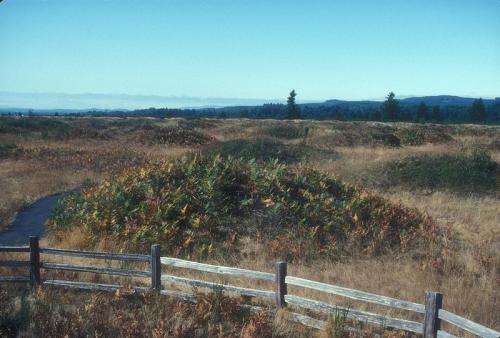December 9, 2013 report
Computer simulation shows Mima mounds likely made by gophers

(Phys.org) —A computer simulation created by a team of researchers at San Jose State University suggests that Mima mounds are almost surely made by pocket gophers. The team has had its findings published in the journal Geomorphology and will be also be presenting what they've discovered later this year at the American Geophysical Union Fall Meeting in San Francisco.
Mima mounds are mounds of Earth that have defied explanation for hundreds if not thousands of years. They cover thousands of square miles of flatlands in the western United States, and because of their large size (up to 7 feet in height and 160 feet in diameter) were thought beyond the building abilities of other creatures. Thus, early explorers in United States believed them to be Native American burial grounds—no human remains have ever been found in them, however. In this new effort, the researchers believe they have solved the mystery by creating a realistic computer simulation of pocket gopher behavior.
When building or expanding their underground tunnels, most gophers push dirt downwards—pocket gophers, on the other hand, push it upwards. This seems counterintuitive though, because one serious problem with underground tunnels is flooding. Pushing dirt upwards leaves more room for water to reside after making its way in—that is, unless the gophers only push on the highest parts of the tunnel—a habit that if carried out over successive generations (for perhaps 700 years) could result in the creation of mounds that very much resemble Mima mounds. In such a case, pushing dirt upwards results in the creation of a living space that resides above ground level and hence free of ground water.
Of course, no one has ever seen a pocket gopher in the process of making such a mound, so the simulation isn't actual proof that they are the builders, but it does show its possible—because of that other studies will almost certainly be undertaken to see if it can be proven, and if so, hopefully put to rest a mystery that has baffled virtually everyone that has seen the odd mounds.
There is one catch to the gopher theory—Mima mounds exist in many countries that don't have gophers. The researchers suggest they likely are the result of other rodents that have developed the same dirt pushing strategy as a means of staying dry.
More information: Biotic origin for Mima mounds supported by numerical modeling, Geomorphology, Available online 3 October 2013. www.sciencedirect.com/science/ … ii/S0169555X13004765
Abstract
Mima mounds are ~ 1-m-high hillocks found on every continent except Antarctica. Despite often numbering in the millions within a single field, their origin has been a mystery, with proposed explanations ranging from glacial processes to seismic shaking. One hypothesis proposes that mounds in North America are built by burrowing mammals to provide refuge from seasonally saturated soils. We test this hypothesis with a numerical model, parameterized with measurements of soil transport by gophers from a California mound field, that couples animal behavior with geomorphic processes. The model successfully simulates the development of the mounds as well as key details such as the creation of vernal pools, small intermound basins that provide habitat for endemic species. Furthermore, we demonstrate that the spatial structure of the modeled mound fields is similar to actual mound fields and provides an example of self-organized topographic features. We conclude that, scaled by body mass, Mima mounds are the largest structures built by nonhuman mammals and may provide a rare example of an evolutionary coupling between landforms and the organisms that create them.
Journal information: Geomorphology
© 2013 Phys.org





















